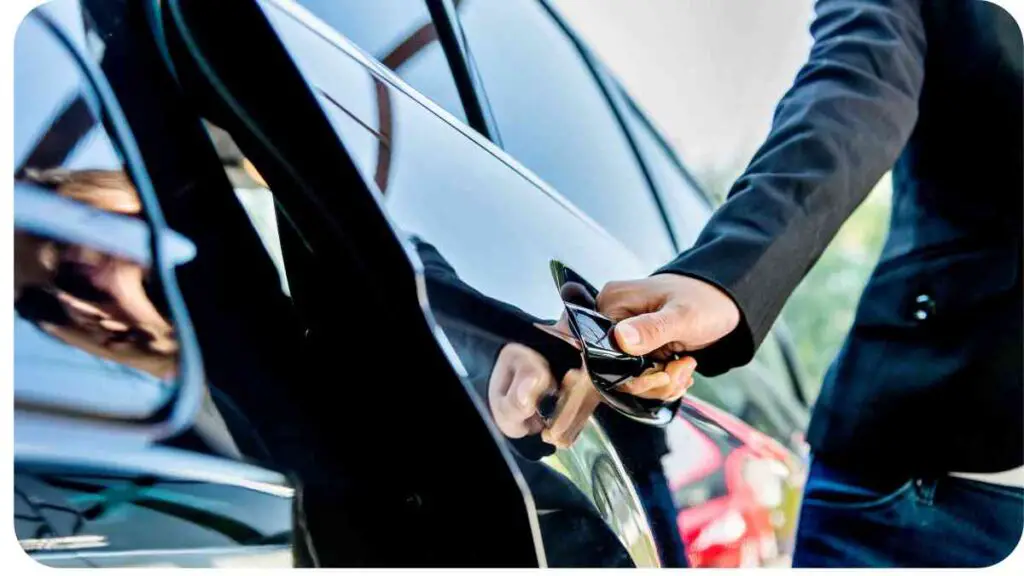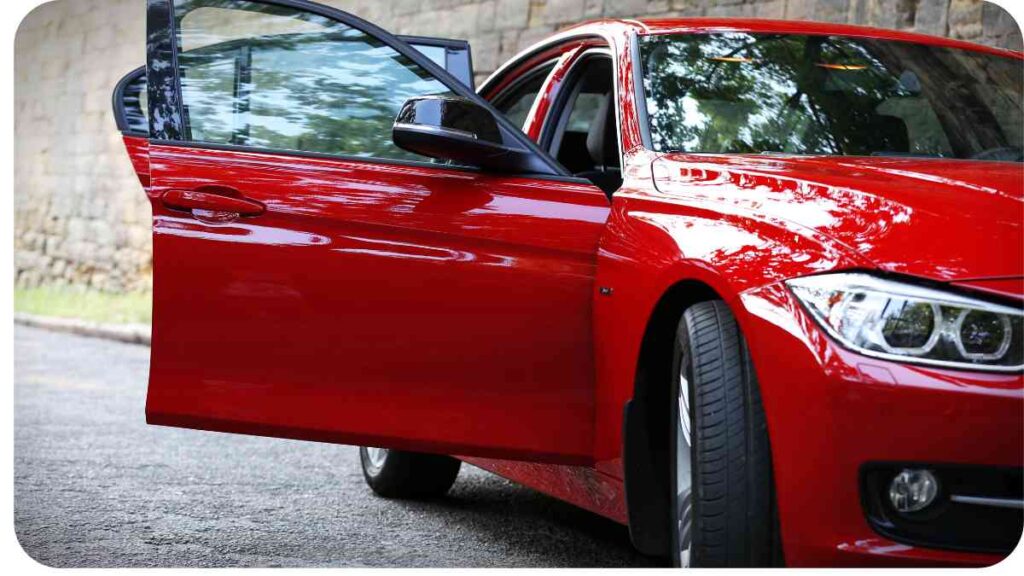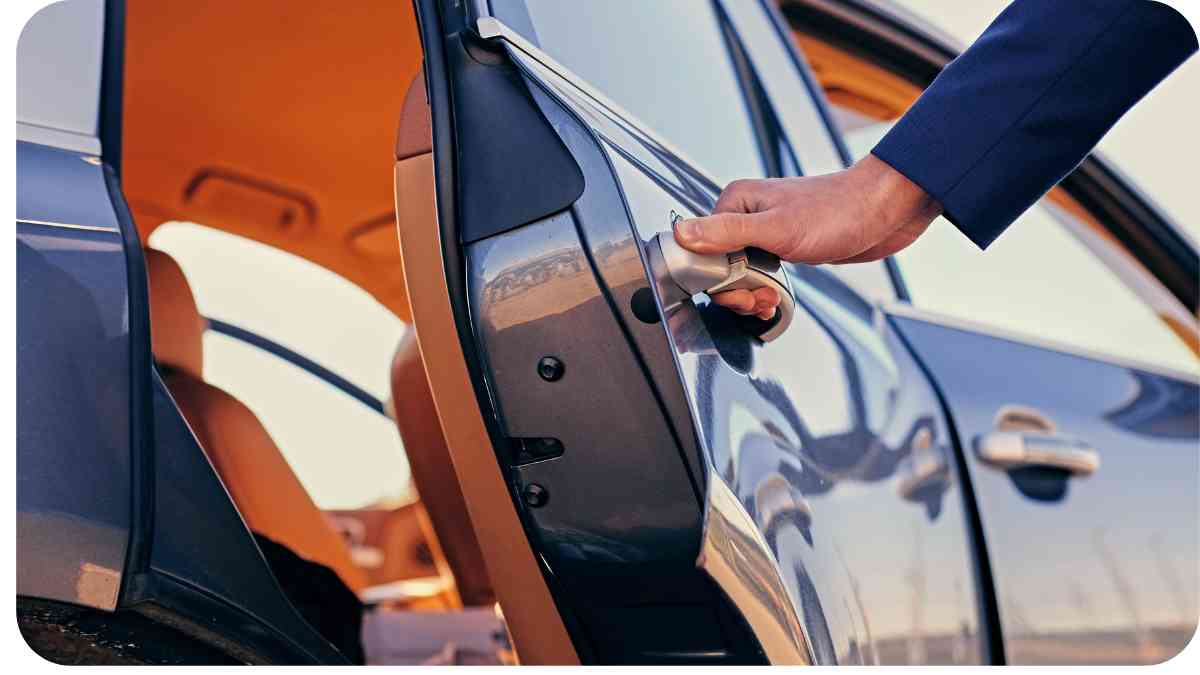Welcome to our comprehensive guide on addressing minor malfunctions in garage door openers installed in cars. Garage door openers are essential for the convenience and safety of homeowners, allowing for easy access to your garage and protecting your vehicle.
In this article, we will explore the common issues that arise with garage door openers in cars and provide practical troubleshooting steps to address them. By following these guidelines, you can save time and money by resolving minor malfunctions on your own.
| Takeaways |
| – Proper lubrication of moving parts helps maintain smooth door movement. |
| – Adjusting the travel limit can resolve issues with doors opening or closing unevenly. |
| – Checking for obstructions in the tracks and sensors prevents door malfunctions. |
| – Tension adjustment should only be performed by a professional to ensure safety. |
| – Wall button unresponsiveness may be due to wiring issues or a faulty button. |
| – Reprogramming the remote control can often fix remote control malfunctions. |
| – Signal interference from nearby devices can disrupt remote control communication. |
| – Resetting the opener’s memory can help resolve remote control and wall button issues. |
| – Regular maintenance and inspection of the opener are essential for optimal performance. |
| – Seek professional assistance for complex or potentially dangerous garage door problems. |
Understanding Garage Door Openers
Before delving into the troubleshooting steps, it’s important to familiarize yourself with the components of a garage door opener and the common malfunctions that can occur. This knowledge will help you better understand the root causes of the issues you may encounter.
Regular car maintenance is crucial for ensuring longevity and reliability. Follow these car maintenance tips to keep your vehicle running smoothly.
Components of a Garage Door Opener

A typical garage door opener consists of the following components:
| Component | Description |
| Motor | Powers the opening and closing mechanism of the garage door |
| Drive Mechanism | Transfers power from the motor to the door |
| Remote Control | Allows you to operate the door opener from your car |
| Wall Button | Mounted on the garage wall, operates the door from within |
| Sensors | Detect obstacles in the door’s path, ensuring safe operation |
| Control Panel | Provides additional functions such as lock and light control |
| Springs and Cables | Counterbalance the weight of the door, enabling smooth movement |
Common Garage Door Opener Malfunctions
Garage door openers can experience various malfunctions over time. Here are some of the most common issues you may encounter:
| Malfunction | Description |
| Remote Control Malfunction | Remote control fails to operate the door opener as intended |
| Inconsistent Door Movement | Door opens or closes unevenly or stalls during operation |
| Unresponsive Wall Button | Pressing the wall button does not activate the door opener |
Safety Precautions
Before attempting any troubleshooting, ensure your safety by following these precautions:
- Disconnect the power to the garage door opener or turn off the circuit breaker before inspecting or working on it.
- Keep fingers and loose clothing away from moving parts.
- Do not attempt repairs beyond your capability. Seek professional assistance for complex issues.
Now let’s dive into troubleshooting the minor malfunctions you may encounter with your garage door opener.
Your vehicle’s health depends on proper care. Discover these expert car maintenance tips to maintain peak performance.
Troubleshooting Minor Malfunctions
In this section, we’ll address three common minor malfunctions that can occur with garage door openers in cars. For each issue, we’ll provide step-by-step troubleshooting techniques to help you resolve the problem promptly and effectively.
Issue 1: Remote Control Malfunction
If your remote control fails to operate the garage door opener, follow these troubleshooting steps:
- Battery Replacement: Check if the remote control’s battery needs to be replaced. Refer to the manufacturer’s instructions for the correct battery type and replacement procedure.
- Reprogramming the Remote Control: Sometimes, reprogramming the remote control can solve the issue. Consult your opener’s manual for the appropriate instructions.
- Checking for Signal Interference: Signal interference can disrupt the communication between the remote control and the opener. Move closer to your garage door, ensuring no obstructions or sources of interference.
- Resetting the Opener’s Memory: Resetting the opener’s memory can refresh its settings and resolve remote control malfunctions. Consult your opener’s manual for instructions on how to perform a factory reset.
Remember, a well-functioning remote control is crucial for an effortless garage door operation, especially when you’re in your car.
Owning a car long-term requires diligence. Use this car maintenance checklist to stay on top of essential tasks.
Issue 2: Inconsistent Door Movement
If your garage door opens or closes unevenly or stalls during operation, here are some troubleshooting steps to address the issue:
- Lubricating Moving Parts: Insufficient lubrication can cause friction and hinder smooth door movement. Apply a lubricant specifically designed for garage door mechanisms to the rollers, hinges, and tracks. Regular lubrication helps maintain optimal performance.
- Adjusting the Travel Limit: If the door stops too early or hits the ground forcefully, adjusting the travel limit can rectify the problem. Consult your opener’s manual to locate the travel limit adjustment screws. Gradually adjust the screws in small increments until the door opens and closes smoothly.
- Checking for Obstructions: Objects obstructing the door’s path can impede its movement. Inspect the tracks for any debris, such as leaves or small rocks, and remove them. Additionally, ensure no items are blocking the door’s sensors located near the ground. Clearing any obstructions helps prevent door malfunctions.
- Tension Adjustment: If the door feels heavy or imbalanced when manually opened, adjusting the tension springs may be necessary. This task requires professional expertise as it involves handling high tension components. Contact a garage door specialist to perform the tension adjustment and ensure safe operation.
By addressing these potential causes, you can restore smooth and consistent movement to your garage door.
Issue 3: Unresponsive Wall Button
If pressing the wall button does not activate the garage door opener, follow these troubleshooting steps:
- Checking the Wiring: Inspect the wiring connecting the wall button to the opener. Look for any loose connections or damaged wires. If you find any issues, consult an electrician or a garage door specialist to repair or replace the wiring.
- Replacing the Wall Button: Over time, wall buttons can deteriorate or become unresponsive. Consider replacing the wall button if other troubleshooting steps don’t resolve the issue. Ensure you choose a compatible replacement to maintain compatibility with your existing opener.
- Resetting the Opener: Similar to troubleshooting remote control malfunctions, resetting the opener’s memory can resolve unresponsive wall button issues. Refer to your opener’s manual for instructions on performing a factory reset.
An operational wall button is vital for controlling your garage door from within. Ensure it functions properly for easy access to your garage.
Continue to the next section for further insights and troubleshooting techniques.
Have questions about car maintenance? Get answers from the pros with these common car maintenance questions.
Addressing Remote Control Malfunctions
When your remote control malfunctions, it can be frustrating and inconvenient. Here, we’ll dive deeper into troubleshooting techniques and provide additional tips to help you address this issue successfully.
Battery Replacement
One of the most common causes of remote control malfunctions is a depleted battery. By replacing the battery, you can often restore its functionality. To replace the battery:
- Locate the battery compartment on the remote control.
- Open the compartment and remove the old battery.
- Insert a fresh battery of the correct type, as specified by the manufacturer.
- Close the compartment, ensuring it is securely fastened.
Regularly check the battery charge to prevent unexpected malfunctions. Replace the battery at the first signs of low power to maintain reliable operation.
Reprogramming the Remote Control
If replacing the battery doesn’t solve the remote control malfunction, reprogramming the remote control might do the trick. Follow these steps to reprogram your remote control:
- Locate the “learn” button on your garage door opener. It is usually found on the back or side of the opener unit.
- Press and release the “learn” button, usually within 30 seconds of starting the programming process. The opener’s indicator light will blink or flash to signify that it is ready to learn the remote control.
- Hold the remote control close to the opener and press the desired button you want to program. This sends a signal to the opener, allowing it to recognize and sync with the remote control.
- The opener’s indicator light should flash or turn steady to confirm successful programming. Test the remote control by pressing the programmed button to ensure the opener responds accordingly.
Reprogramming the remote control establishes a new connection between the remote and the opener, often resolving any communication issues. If you have multiple remotes, repeat the steps for each one.
Keep your car in great shape while saving money. Explore ways to save on car maintenance and repairs with smart strategies.
Checking for Signal Interference
Signal interference can disrupt the communication between the remote control and the opener, leading to malfunctions. To check for signal interference:
- Stand close to the garage door opener with the remote control in hand.
- Press the remote control button while observing its response.
- If the door doesn’t operate or responds intermittently, move closer to the opener. Sometimes, the signal might weaken due to distance.
- If the issue persists, ensure there are no sources of signal interference nearby. Common culprits include electronics, Wi-Fi routers, or other wireless devices. Temporarily turning off or moving such devices away can help identify the source of interference.
By eliminating signal interference, you can enhance the reliability and effectiveness of your remote control.
Resetting the Opener’s Memory

Resetting the opener’s memory can provide a fresh start and often resolves remote control malfunctions. Here’s how you can reset the memory of your garage door opener:
- Locate the “learn” button on your opener. It is typically found near the “program” or “set” buttons.
- Press and hold the “learn” button for approximately 10-15 seconds until the indicator light on the opener turns off or blinks, indicating that the memory has been cleared.
- Release the “learn” button and wait for a few moments.
- Press the desired button on your remote control to reprogram it. The opener’s indicator light should blink or turn steady to indicate successful programming.
Resetting the opener’s memory helps eliminate any conflicting or outdated information stored in the system, ensuring a clean slate for programming remote controls.
Remember to test the remote control after resetting the opener to ensure it operates the door as intended.
Now that we have covered remote control malfunctions, let’s move on to addressing inconsistent door movement.
Fixing Inconsistent Door Movement
When your garage door opens or closes unevenly, stalls, or moves erratically, it can be a frustrating experience. Let’s explore potential solutions to address these issues and restore smooth door movement.
Lubricating Moving Parts
One of the common causes of inconsistent door movement is insufficient lubrication. Over time, the moving parts of the garage door opener can become dry, leading to increased friction. By lubricating these components, you can improve the operation of your garage door. Here’s how:
- Use a garage door lubricant specifically designed for the opener’s moving parts. Avoid using grease or oil, as they may attract debris and cause further issues.
- Apply the lubricant to the rollers, hinges, and tracks according to the manufacturer’s instructions. Coat these components evenly, ensuring proper coverage.
- Operate the door a few times to distribute the lubricant and allow it to penetrate the moving parts effectively.
By lubricating the moving parts, you reduce friction and ensure smooth and consistent door movement.
Adjusting the Travel Limit
If adjusting the travel limit doesn’t resolve the inconsistent door movement, you can try the following steps:
- Checking for Obstructions: Inspect the tracks and rollers for any obstructions such as debris, dirt, or small objects. Remove any obstructions to ensure smooth movement of the door.
- Tension Adjustment: In some cases, the tension of the garage door springs may need adjustment. However, adjusting the tension springs is a complex task and should only be performed by a trained professional. Contact a garage door specialist to assess and adjust the tension springs if necessary.
- Inspecting and Replacing Worn Components: Over time, various components of the garage door opener, such as the rollers, hinges, and cables, can wear out and contribute to inconsistent door movement. Inspect these components for any signs of wear or damage. If any parts appear worn or damaged, consider replacing them to restore proper functionality.
Remember, adjusting garage door mechanisms can be dangerous, especially when dealing with high-tension springs. If you’re uncertain or uncomfortable performing these tasks yourself, it’s best to seek assistance from a professional garage door technician.
Resolving Unresponsive Wall Button
If the wall button fails to activate the garage door opener, follow these troubleshooting steps:
- Checking the Wiring: Examine the wiring connecting the wall button to the opener. Look for any loose connections, frayed wires, or corrosion. If you identify any issues with the wiring, consult an electrician or a professional garage door technician to repair or replace the wiring.
- Replacing the Wall Button: If the wiring appears to be intact, the wall button itself may be faulty or worn out. Consider replacing the wall button with a compatible replacement. Ensure you turn off the power to the opener before attempting any replacements, and follow the manufacturer’s instructions for installation.
- Resetting the Opener: Similar to troubleshooting remote control malfunctions, resetting the opener’s memory can sometimes resolve unresponsive wall button issues. Consult your opener’s manual for instructions on performing a factory reset.
By addressing these potential causes, you can restore proper functionality to the wall button and regain convenient control of your garage door.
Now, let’s summarize the key points covered in this guide.
Conclusion
In this comprehensive guide, we have addressed common minor malfunctions that can occur with garage door openers in cars. By understanding the components of a garage door opener and following the troubleshooting steps provided, you can resolve issues with remote control malfunctions, inconsistent door movement, and unresponsive wall buttons.
Remember, safety is paramount when handling garage door openers. If you encounter complex issues or feel uncomfortable performing any tasks, it’s best to seek assistance from a professional garage door technician.
Further Reading
Here are some additional resources that you may find helpful in troubleshooting and resolving common garage door opener problems:
- Troubleshooting Common Garage Door Problems: The Spruce provides a comprehensive guide to troubleshooting various garage door issues, including opener problems, sensor issues, and door alignment.
- Troubleshooting Garage Door Openers: Family Handyman offers a detailed article on troubleshooting garage door opener problems, covering issues such as remotes not working, motor malfunctions, and door reversals.
- Solutions for Common Garage Door Problems: AllStyle Garage Door lists common garage door problems you might encounter, along with practical solutions and tips for resolving them.
Feel free to explore these resources for more in-depth information and guidance on troubleshooting and fixing garage door opener issues.
FAQs
Here are some frequently asked questions related to garage door openers and their answers:
Q: Why is my garage door not closing all the way?
A: There could be several reasons why your garage door is not closing completely, including misaligned photo-eye sensors, faulty limit settings, or worn-out rollers. Check these components and make the necessary adjustments or repairs to ensure proper door closure.
Q: Why won’t my remote control open the garage door?
A: Several factors may cause remote control issues, such as dead batteries, signal interference, or programming errors. Try replacing the batteries, reprogramming the remote control, or troubleshooting signal interference to resolve the problem.
Q: Why does my garage door opener make a grinding noise?
A: A grinding noise from the opener can indicate various issues like worn-out gears, loose chains, or lack of lubrication. Inspect and maintain the opener, tighten any loose components, and apply lubrication as needed.
Q: What should I do if my garage door opener motor runs but the door doesn’t move?
A: If the opener motor runs but the door isn’t moving, it may be due to a broken or disengaged trolley, worn-out gears, or a malfunctioning drive belt. Inspect these components and replace or repair them as necessary.
Q: How often should I perform maintenance on my garage door opener?
A: Regular maintenance is important to ensure the smooth operation of your garage door opener. It is recommended to perform maintenance tasks, including lubrication, inspection, and testing, at least once a year to keep the opener functioning properly.
Remember, if you encounter complex or potentially dangerous problems, it’s best to consult a professional garage door technician for assistance.

Hello friends. My name is Hellen James and I’m here to help you make good decisions when it comes to buying, selling, and maintaining your vehicles.


